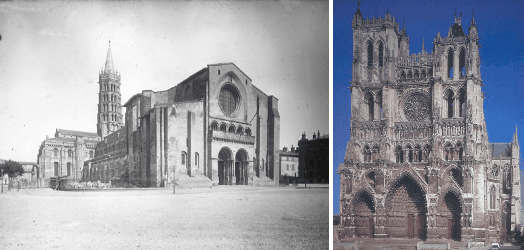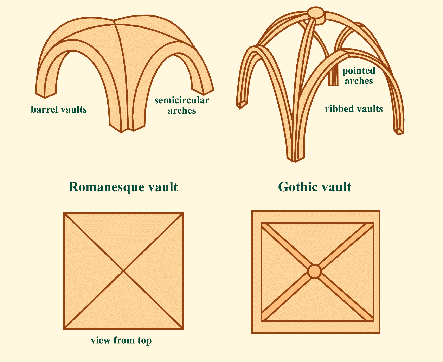Two main art styles that dominated the Middle Ages are the Romanesque and Gothic styles. Both styles apply mostly to architecture. The former style began in the 9th century and lasted until the 12th century. It was succeeded by the latter style that began in the 12th century and lasted until the 15th century.

Outstanding examples of both styles are Saint-Sernin Basilica in Toulouse, France that represents the Romanesque style, and Amiens Cathedral in Saleux, France that is representative of the Gothic style (Rice University).
The first similarity between the two styles is their origin and structure-location. Both originated in Europe and the structures resulting from both styles of art lie within the same continent. The second similarity is their religious orientation. Both styles have their basis in Christianity; both styles constructed structures that are identifiable with the Christian religion. The third similarity relates to certain features of architecture which both styles treat similarly. These are interior general view, interior aisles, interior choir/transept, and aisle vaults (Rice University).
Among the many differences in both styles, the most prominent one relates to the Arches and Vaults, diagrams of which are depicted below (Athena Review):

In continuation of Roman tradition, Romanesque arches are semicircular in shape. Following the Islamic architecture of the Near East during the 8th century, Gothic arches are pointed (Athena Review). Using local brick laced with limestone, the Romanesque style features barrel vaults with transverse arches over them, while the galleries and side aisles have quadrant and groin vaults over them respectively. Using prefabricated limestone, the Gothic style features ogival or ribbed vaults; these are superior to barrel vaults because while the latter spreads the weight and thrust along the wall equally, the former aims the thrust at areas where the ribs meet the wall in clerestory level masonry, whose weight is borne by the flying buttresses on the exterior of the structure (Rice University).
The second difference between the two styles is the Exterior General View. The Romanesque style has characteristic readability involving all the architectural elements as well delineated units that are added one to another to form a pyramid-shaped building comprising distinct geometrical forms. The Gothic style locates all the architectural components on the outside of the structure to form a radial armature that bears the weight of big stained glass walls. The third difference is the Exterior Windows. While the Romanesque style has few windows spaces with simple lancets, the Gothic style has a larger number of windows with many lancets characterized by ‘sticks of stone’ collected together under an oculus. The fourth difference is the Interior Elevation. The Romanesque style has a two-story elevation including arcade and vaulted gallery bearing the weight of a longitudinal barrel vault strengthened by transverse arches. The Gothic style has a three-story elevation including arcade , triforium with pathway and clerestory window (Rice University). The last difference is the Sculpture. Romanesque sculptors carved capital of pillars with strikingly bright biblical pictures or endearingly misshapen gargoyles craftily made to fill most of the available space. They also carved the tympanum with vivid biblical scenes, their favorite being the Last Supper. In contrast to the Romanesque choice of squat, chunky and angular figures, Gothic sculptors preferred unusually tall and thin figures. For example, the triple entrance in the west façade of the Chartres Cathedral in France features biblical kings and queens with realistic and kind facial expressions standing on a small ledge jutting from a slim, tall pillar. Their bodies unbelievably lengthened, are enveloped in rolling pleats of full-length robes.
As a result of the many differences in both styles of architecture, the overall effect is visible in the Interior Space of structures. As a result of the rounded arches, barrel vaults, thick walls, and heavy piers, the interior space of Romanesque-style structures is dim, gloomy, and motionless. The Gothic style’s pointed arches, ribbed vaults, skeletal system, and flying buttresses result in interior space that is bright, energetic, purposeful, and fluid (Rice University).
References
“Gothic and Romanesque Architecture.” Rice University. 1996. Web.
“Gothic Architecture.” Athena Review. 2006. Web.
“History of Sculpture.” Historyworld.net. (N.d). Web.